in 2016, each individuals required contribution to medicare was what percentage of all earnings
On November 10, 2015, the Centers for Medicare & Medicaid Services (CMS) announced the 2016 Medicare Role B monthly premium and annual deductible amounts of $121.fourscore and $166, respectively.1 The Medicare Trustees had projected that Office B premium and deductible amounts would increase past an unprecedented 52 percent between 2015 and 2016,2 before the Bipartisan Budget Act of 2015 (Public Law 114-74) was passed by Congress and signed into law on November two, 2015. According to the Trustees, the magnitude of the projected increase in the standard premium was attributable to college-than-expected Function B spending in 2014; a need to provide for adequate reserves in the Supplementary Medical Insurance trust fund; and the effect of having no cost-of-living adjustment (COLA) for Social Security benefits in 2016. The lack of a Social Security COLA means that seventy pct of Part B enrollees are prevented from paying college Part B premiums in 2016 due to the and then-called 'hold-harmless' provision in the Social Security constabulary, while the other 30 per centum will face up higher premiums.3
Every bit a result of the Bipartisan Budget Act of 2015, the Part B monthly premium will be increasing for 30 pct of Part B enrollees from $104.xc in 2015 to $121.80 in 2016—a 16 percentage increase, but far less than the increase initially projected by the Medicare actuaries (Figure 1). This total amount includes a $3 repayment surcharge, which volition be added to monthly premiums over time to cover the toll of the reduced premium rate in 2016. The 70 percentage of Part B enrollees who are protected by the agree-harmless provision will pay a monthly premium of $104.90 in 2016, the same as in 2015, and no premium surcharge.
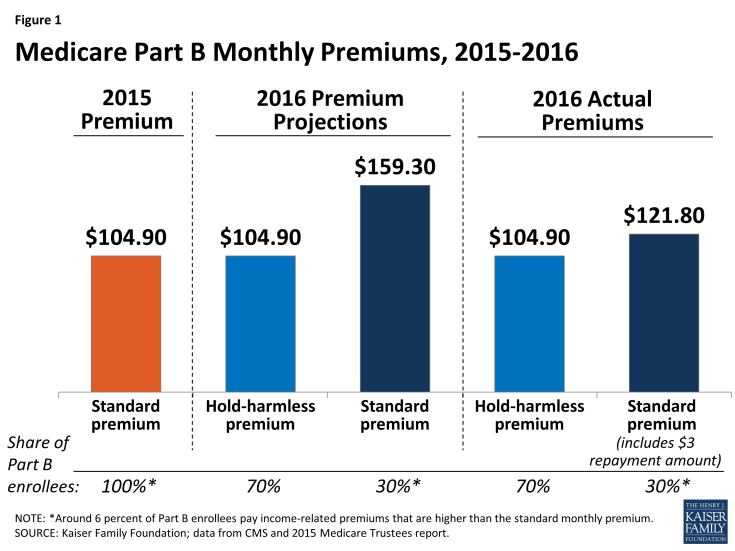
Effigy 1: Medicare Part B Monthly Premiums, 2015-2016
This brief explains how the Medicare Part B premium and deductible are irresolute for 2016, the circumstances that led lawmakers to modify the formula for determining these amounts for 2016, related provisions of the Bipartisan Budget Human activity of 2015, and the implications for beneficiaries' premiums and deductibles in 2016 and future years.
How are Medicare Part B premiums calculated?
Medicare's monthly standard Part B premium amount is derived from a monthly actuarial rate determined by the Secretarial assistant of the Department of Health and Man Services (HHS) in September of each year for the succeeding year, such that, in the aggregate, premiums will cover 25 percentage of Part B program spending and provide for adequate reserves in the Supplementary Medical Insurance (SMI) Trust Fund, with general revenues covering the remaining 75 percent of plan spending. Most beneficiaries pay the standard premium corporeality, while college-income Part B enrollees pay a greater share of costs, ranging from 35 percent to 80 percentage, depending on their income, and state Medicaid programs pay the premium on behalf of beneficiaries who are dually eligible for Medicare and Medicaid. Premiums are generally deducted from beneficiaries' Social Security benefits.four
Over the 50-year history of the Medicare program, Office B premiums have changed nearly every year past varying percentages, ranging from a reduction of 13 percent to an increase of 39 percent. In full general, premiums have increased from ane year to the side by side, reflecting the growth in Part B program spending (see Appendix A for actual and projected Part B premiums and rates of growth between 1975 and 2024).
In July 2015, the Medicare Lath of Trustees projected that the monthly Part B premium would increase by an unprecedented 52 percent for 30 percent of Part B enrollees, triggered by the lack of a Social Security price-of-living adjustment (COLA) for 2016, while the other 70 pct of Part B enrollees would pay the aforementioned premium in 2016 that they pay in 2015 ($104.90) because of the hold-harmless provision in the Social Security law.5
What is the connection between the Medicare Part B premium, the Social Security COLA, and the hold-harmless provision?
Social Security recipients typically receive an annual toll-of-living increase that reflects college costs associated with inflation (see Appendix A for bodily and projected Social Security COLAs between 1975 and 2024). The COLA is based on the modify in the Consumer Cost Alphabetize for Urban Wage Earners and Clerical Workers (CPI-W) between the third quarter (July-September) of the current year and the third quarter of the most contempo year a cost-of-living adjustment was determined.vi For 2016, the COLA is based on the change in the CPI-Due west between the third quarters of 2014 and 2015, a menses marked by dramatic declines in free energy prices (primarily the price of gasoline) that outweighed pocket-sized cost increases in other consumer goods.7 As a result, on October 15, 2015, Social Security announced there will be no COLA for 2016.8 The nothing percent COLA for Social Security recipients in 2016 is the first yr with no COLA since 2011 and only the third such twelvemonth since 1975.
The absence of a COLA affects the amount of the Medicare Part B premium charged to enrollees considering it triggers the broader awarding of a provision in the Social Security law known as the concur-harmless provision. In a year where the Social Security COLA is insufficient to cover the amount of the Medicare Part B premium increment for an individual, the constabulary prohibits an increment in the Office B premium that would result in a reduction in that individual's monthly Social Security benefits from ane yr to the next. (For an case of how the hold-harmless provision works in a typical yr with a Social Security COLA, see Appendix B.) The hold-harmless provision affects a different number of beneficiaries each yr, depending on the level of their Social Security benefits, the size of the COLA, and the increment in the Medicare Part B premium. In years with no COLA, a bulk of beneficiaries are protected by the concur-harmless provision.
Which Medicare beneficiaries volition non be protected by the hold-harmless provision in 2016?
In 2016, 30 percent of all Part B enrollees volition not be protected by the hold-harmless provision,ix including (Effigy 2):
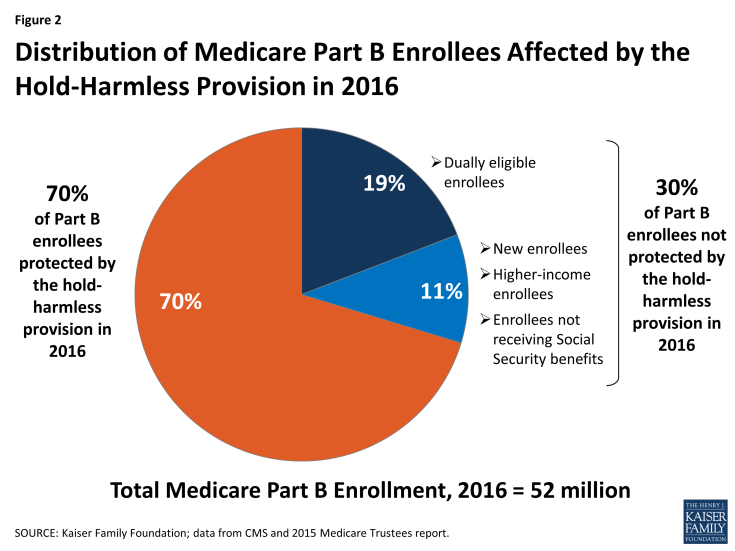
Figure 2: Distribution of Medicare Part B Enrollees Afflicted by the Concur-Harmless Provision in 2016
- Medicare beneficiaries who are dually eligible for Medicare and Medicaid, for whom State Medicaid programs (funded jointly by states and the Federal government) pay the monthly Part B premium, and any increase in the premium, on their behalf. There are approximately 10 million dually eligible beneficiaries, representing 19 per centum of Part B enrollees and two-thirds of those who are not protected by the hold-harmless provision.
- Higher-income Medicare beneficiaries, with a modified adjusted gross income greater than $85,000 for individuals and $170,000 for couples in 2016, who are required to pay an income-related surcharge in addition to the standard monthly Part B premium amount.
- Medicare Part B enrollees who are not receiving Social Security benefits, including people covered nether Medicare Part B who have called to defer receiving Social Security benefits, and others who are covered under Medicare just not Social Security. In 2013, one-half of all people on Medicare not receiving Social Security benefits had incomes below $33,000.ten
- New Medicare enrollees in 2016. Because people who are new to Medicare in 2016 have non been paying Part B premiums in 2015, the increment in the Part B premium cannot result in a decrease in their Social Security benefits in 2016. This group includes people reaching age 65 in 2016 who enroll in Medicare Part B, and people who worked beyond historic period 65 and sign upward for Function B in 2016. It also includes people younger than age 65 who have been receiving Social Security Disability Insurance (SSDI) payments who volition exit the 24-month waiting catamenia and keep Medicare in 2016. The Medicare actuaries project the number of Part B enrollees volition increment by 1.4 million between 2015 and 2016,eleven all of whom will pay a higher Office B premium unless they qualify for both Medicare and Medicaid, in which instance states pay the premium on their behalf.
How did the Bipartisan Upkeep Act of 2015 affect Medicare Part B premiums in 2016 and across?
In response to the unusual circumstances surrounding the projected Medicare Part B premium increment for 2016, the recently-passed Bipartisan Upkeep Act of 2015 modified the mode in which the Part B premium and deductible amounts are calculated for 2016. The constabulary requires Medicare to calculate the standard Part B premium for 2016 equally if the concur-harmless provision were not in effect and as if all Part B enrollees (rather than just 30 percentage) were paying a higher amount. This approach has the result of reducing the standard Role B premium amount for the 30 percent of Function B enrollees who are not protected past the hold-harmless provision.
In accord with the new law, CMS announced that the total Office B monthly premium amount for 2016 will be $121.eighty, which includes a $iii repayment amount that will be added to monthly premiums over time to embrace the toll of the reduced premium charge per unit in 2016, as described below. This total premium volition be paid by (or on behalf of) the thirty percent of Office B enrollees who are not protected by the hold-harmless provision in 2016. The total (including the repayment amount) represents a 16 pct ($16.90) increase from the 2015 standard monthly premium of $104.90, and $37.fifty less than actuaries had projected for 2016 before this year. Based on CMS'due south calculation of the 2016 actuarial charge per unit of $237.60, the monthly premium charge per unit lonely, excluding the $three repayment corporeality, is $118.80, or thirteen percent more than the 2015 monthly premium (Figure 3).
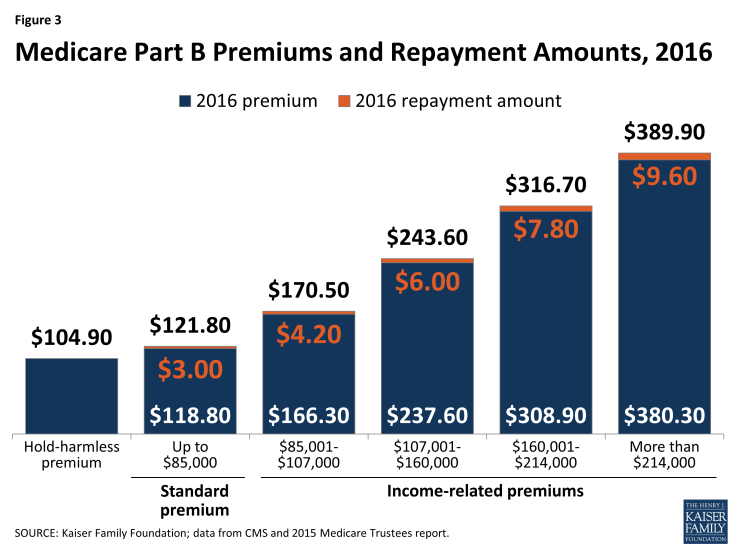
Figure 3: Medicare Office B Premiums and Repayment Amounts, 2016
Thus, under the new law, beneficiaries who are non protected by the agree-harmless provision will pay more than the 2015 standard Part B premium in 2016, but non as much as was projected in the 2015 Trustees report. Beneficiaries who are protected by the hold-harmless provision will pay $104.90 per month in 2016, the same as the standard Function B premium in 2015, and no repayment amount.
According to CMS, this modify in the adding of the Part B premium for 2016 will cost $7.four billion in federal outlays because there will be a shortfall in beneficiary premium payments in 2016.12 CMS also estimated that states will salve a total of $1.8 billion on premium payments for dually-eligible beneficiaries due to the actual premium for 2016 being lower than what was initially projected.
The law calls for a transfer of funds from general revenues to the SMI trust fund to temporarily encompass the $7.iv billion cost, but also requires Part B enrollees to repay this corporeality over fourth dimension in the class of a modest premium surcharge. Beginning in 2016, a $3 repayment surcharge will be added to the monthly premium payment for the 30 percent of beneficiaries who are not protected by the hold-harmless provision; beneficiaries who pay income-related premiums volition pay somewhat college repayment amounts.
In 2017 and afterward years until the full cost is repaid, the repayment surcharge will be added to the monthly Part B premium amount paid past all Role B enrollees who are not protected past the concur-harmless provision. For those years where in that location is a Social Security cost-of-living increase, the vast majority of Part B enrollees volition not be protected by the hold-harmless provision and volition be required to pay these repayment amounts.
How will Part B premiums change for college-income Medicare beneficiaries in 2016?
Approximately 6 percent of Part B enrollees are estimated to pay income-related Function B premiums in 2016.13 Beneficiaries are required to pay a higher Part B premium if their income is equal to or greater than $85,000 for an individual and $170,000 for a couple. These beneficiaries pay a higher share of Part B program costs, ranging from 35 per centum to 80 pct, depending on their income level. For 2015, the income-related Part B premium amounts range from $146.90 for beneficiaries paying 35 percent of program costs to $335.70 for beneficiaries paying 80 per centum of costs.
For 2016, the monthly income-related premiums (including the repayment amounts) will increase by xvi pct, the same percentage increase at each level every bit for the standard Part B premium. For higher-income beneficiaries, monthly premiums volition range from $170.50 (for those with incomes between $85,001 and $107,000) to $389.90 (for those with incomes greater than $214,000) (Figure 4). These amounts include the monthly surcharges, which range from $4.20 for beneficiaries paying 35 percent of program costs to $nine.60 for beneficiaries paying 80 percent of costs.
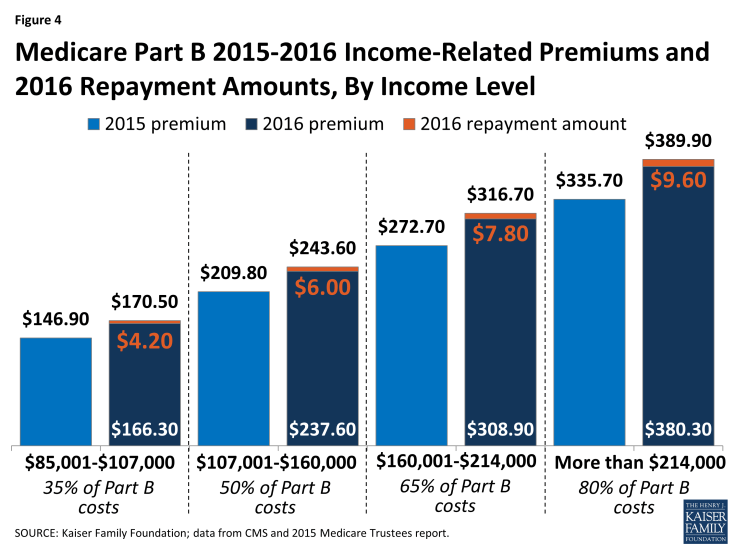
Figure four: Medicare Function B 2015-2016 Income-Related Premiums and 2016 Repayment Amounts, Past Income Level
How is the Medicare Function B deductible changing in 2016?
The Medicare Part B deductible was projected to rise by 52 percent in 2016, because the premium and deductible amounts are indexed to increment at the same charge per unit. Thus, changes to the calculation of the standard Part B premium made in the Bipartisan Upkeep Human activity of 2015 also afflicted the deductible. The almanac Part B deductible will exist $166 in 2016, increasing by $xix over the 2015 corporeality of $147 (Figure 5). This represents the same rate of increase (xiii pct) as the increase in the monthly Part B premium excluding the repayment surcharge. The annual deductible for 2016 is $57 lower than the $223 amount that was projected by the Medicare Trustees in the 2015 written report.
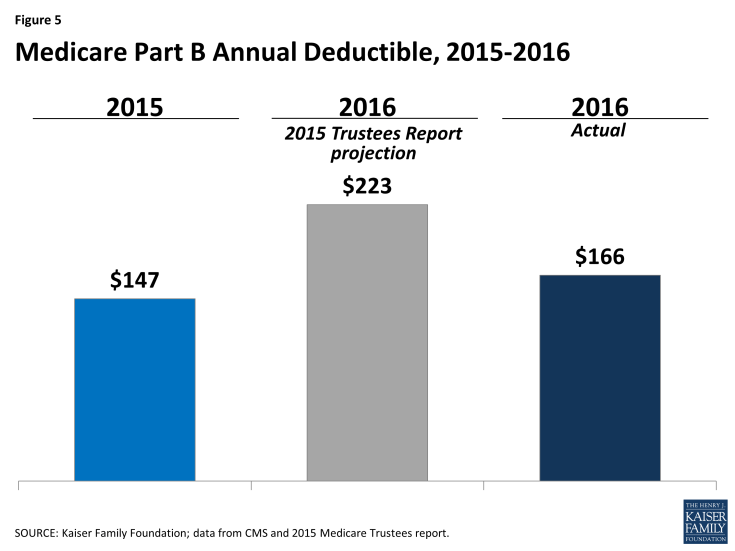
Effigy 5: Medicare Part B Annual Deductible, 2015-2016
The hold-harmless provision does not apply to the Part B deductible increase, thus all Office B enrollees who use Part B services will exist charged this higher amount. An exception is Medicare Advantage enrollees, who typically pay the Part B premium simply may non face the same cost-sharing requirements for Medicare-covered services as beneficiaries in traditional Medicare, including deductibles and coinsurance or cost sharing. Beneficiaries in traditional Medicare who have Medigap supplemental coverage or employer-sponsored plans that help encompass their Medicare cost-sharing requirements may not pay the higher Part B deductible directly out of their own pockets, but they could face an increment in their Medigap or employer plan premiums as a issue of their plans covering the higher deductible.
What is the expected outlook for 2017?
The Medicare Trustees projected that the Part B monthly premium will be $120.seventy in 2017 and the Part B deductible will be $169—similar to the bodily amounts in 2016. With the addition of the $3 repayment amount, the total monthly premium in 2017 would be $123.70. This total amount represents an 18 percent ($eighteen.80) increase for the bulk of beneficiaries who are protected by the hold-harmless provision in 2016 and a more than pocket-sized two percent ($i.90) increase for all others who are subject to the college premium corporeality in 2016—including states, which pay the Part B monthly premium on behalf of dually eligibles beneficiaries.
For the coming years, the Trustees projection Medicare's monthly Role B premium and deductible will increase at an average annual rate of 5.4 percent between 2017 and 2024. This projected rate of growth is roughly in line with the rate of growth in Medicare Part B per capita spending, and besides reflects the expectation that Social Security recipients will receive a price-of-living increase each year between 2017 and 2024. If Part B spending grows faster or slower than projected, premiums would abound faster or slower as a result.
The Social Security Trustees project a 3.ane percent COLA for 2017, which would result in an increment in monthly Social Security benefits in 2017.14 With an increment in the COLA projected for 2017, fewer Medicare Role B enrollees will be affected by the hold-harmless provision than in 2016, which means the beneficiary premium portion of Role B program spending is likely to exist spread across a greater share of Part B enrollees in 2017 than in 2016, and the repayment surcharges will be paid by a larger share of beneficiaries equally well.
Conclusion
The Bipartisan Budget Act of 2015 averted an unprecedented increase in the 2016 Medicare Function B premium for the 30 percentage of Role B enrollees who would accept otherwise have faced a 52 percent increment in their premiums. It as well reduced the level of increase in the Function B deductible that would have affected near all beneficiaries in traditional Medicare. Although the hold-harmless provision protects most beneficiaries against an increase in the Part B premium in a year with no COLA, some beneficiaries could run across an bodily reduction in their Social Security benefits in 2016 due to ascent Function D drug plan premiums—which are increasing past 13 pct on average between 2015 and 2016fifteen—because the agree-harmless provision applies only to premiums for Part B, not Part D. And the absence of a COLA for 2016 in and of itself has direct financial implications for roughly 60 meg Social Security recipients, many of whom alive on stock-still incomes and rely on Social Security benefits equally their primary source of income.16 Thus, in the face of flat Social Security benefits and ascension out-of-pocket costs, many people on Medicare could have greater difficulty affording their medical intendance costs in the coming twelvemonth.
Source: https://www.kff.org/medicare/issue-brief/whats-in-store-for-medicares-part-b-premiums-and-deductible-in-2016-and-why/
0 Response to "in 2016, each individuals required contribution to medicare was what percentage of all earnings"
Enregistrer un commentaire